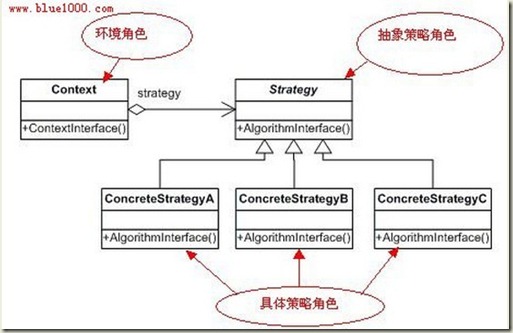思想本质:策略模式将具体的策略与用户隔离,用户不知道使用的具体策略,这样我们就可以根据需要灵活地替换我们的策略。
策略模式的类图如下:
Strategy是策略抽象类,有很多的具体策略类继承它,Context负责与用户的交互,同时可以使用不同的具体策略来配置Context。下面我们以对数组的排序
来实现并说明策略模式。
1: /* abstract strategy class******************************/2: class Strategy3: {4: public:5: virtual void Sort(int array[], int n) = 0;6: virtual ~Strategy()7: {8:9: }10: };11:12: /* SelectSortionStrategy class, Strategy's child********/13: class SelectSortionStrategy: public Strategy14: {15: virtual void Sort(int array[], int n);16: };17:18: void SelectSortionStrategy::Sort(int array[], int n)19: {20: int tag;21: for(int i = 0; i < n-1; i++)22: {23: tag = i;24: for(int j = i+1; j < n; j++)25: {26: if(array[j] < array[tag])27: {28: tag = j;29: }30: }31:32: int tmp;33: tmp = array[i];34: array[i] = array[tag];35: array[tag] = tmp;36: }37: }38:39:40:41: /* InsertSortionStrategy class, Strategy's child********/42: class InsertSortionStrategy: public Strategy43: {44: virtual void Sort(int array[], int n);45: };46:47: void InsertSortionStrategy::Sort(int array[], int n)48: {49: int key;50: for(int i = 1; i < n; i++)51: {52: int j;53: key = array[i];54: for(j = i-1; j >= 0; j--)55: {56: if(array[j] > key)57: {58: array[j+1] = array[j];59: }60: else61: {62: break;63: }64: }65:66: array[j+1] = key;67: }68: }69:70:71: /* Context class****************************************/72: class Context73: {74: private:75: Strategy* m_pStrategy;76: public:77: Context(Strategy* pStrategy);78: void ContextSort(int array[], int n);79: ~Context();80: };81:82: Context::Context(Strategy* pStrategy)83: {84: m_pStrategy = pStrategy;85: }86:87: Context::~Context()88: {89: if(m_pStrategy)90: delete m_pStrategy;91: }92:93:94: void Context::ContextSort(int array[], int n)95: {96: m_pStrategy->Sort(array, n);97:98: }排序策略有很多种,这里只实现了插入排序和选择排序,我们通过用不同的策略来配置Context,就可以实现用不同的排序算法来排序。同时可扩展性也好,如
果将来要增加快速排序等策略,只需要派生一个类就可以。单元测试也很方便,各种策略各自封装成一个类,可以进行单独测试。以下是用户端代码示例:
1: #include <iostream>2:3: #include "simpleFactory.h"4: #include "strategy.h"5:6: using namespace std;7:8: void printArray(int array[], int n)9: {10: for(int i = 0; i < n; i++)11: {12: cout<<array[i]<<"\t";13:14: }15: cout<<endl;16: }17:18: int main(int argc, char* argv[])19: {20: // client code21: int a[] = {25,586,58,6958,2564,235,545,658,742,2};22: Context insertContext(new InsertSortionStrategy);23: insertContext.ContextSort(a, sizeof(a)/sizeof(int));24: printArray(a, sizeof(a)/sizeof(int));25:26: int b[] = {25,586,58,6958,2564,235,545,658,742,2};27: Context selectContext(new InsertSortionStrategy);28: selectContext.ContextSort(b, sizeof(b)/sizeof(int));29: printArray(b, sizeof(b)/sizeof(int));30:31: return 0;32: }示例中我用两种不同的策略来排序相同的数组,输出结果是一样的。从用户代码可以看到,在创建Context的时候,要是要用具体的策略来配置,也就是说用户
是需要知道Context类和各种具体策略的,这是策略模式的不足,为了弥补这个不足,可以用策略格式和简单工厂模式结合,从而解决由用户来创建策略对象的
问题。
2011年5月24日星期二
设计模式之C++实现(二)---策略模式(Strategy)
订阅:
博文评论 (Atom)

没有评论:
发表评论